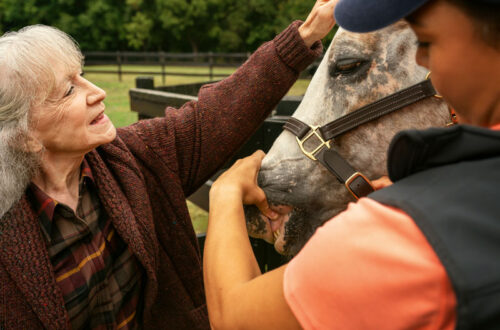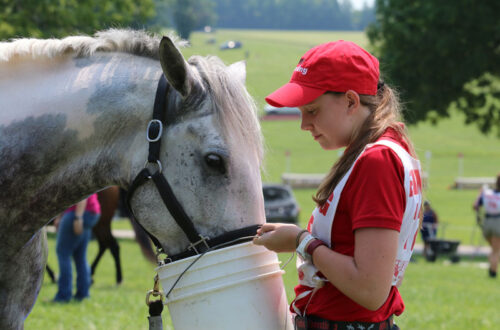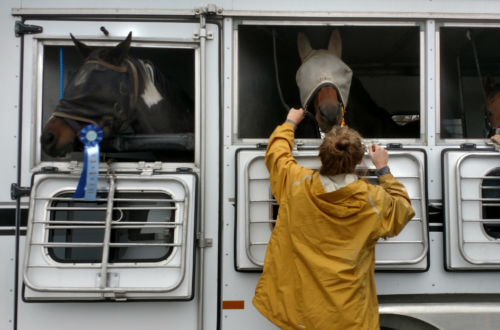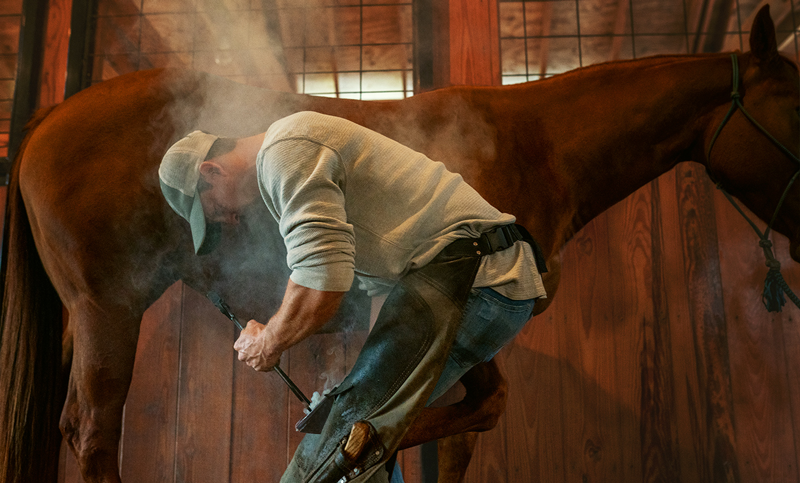
Tips to Prepare for Successful Hoof Care Visits
By Diego Almeida, CJF, EE, FE, TE, AWCF; In partnership with Zoetis Equine, USPC’s Official Health and Wellness Partner
Your horse’s care team is one you’ve likely built through trusted referrals and research between trimming or shoeing appointments, veterinarian visits, day-to-day feeding, care, and more. And when it comes to your horse’s hoof care, farriers are your foot health and functionality experts.
A horse’s hoof is so much more than just the keratin-based hoof wall, sole, and frog we see on the outside—it’s a true foot, with a complex inner structure of bones, tendons, ligaments, nerves, and vasculature. Without regular, professional hoof care, we have “no horse,” as the saying goes.
In addition to providing regular hoof maintenance, farriers also collaborate with veterinarians on lameness and other foot health problems to make strategic trimming and shoeing choices that support their treatment plans. Common conditions that veterinarians and farriers collaborate on include:
- Laminitis
- Keratoma
- White line disease
- Hoof punctures and abscesses
- Hoof wall resections
- Diagnosis and management of Navicular Syndrome
- Coffin bone injuries
- Angular limb deformities in foals
As program director at a university-based farrier school, as well as in my private practice, I get the chance to work with both horse owners and veterinarians in a variety of hoof care situations. I believe the following key tips can help horse owners prepare for successful hoof care appointments.
Horsemanship is Key to Farrier Safety
To be ready for a farrier appointment, horses must learn the skill of standing quietly when held and when tied. Groundwork and preparatory foot handling by someone experienced in horse training is incredibly important—ideally when your horse is still young—but it’s relevant for adult horses, too. Recognize that farriers aren’t horse trainers, and any time spent getting your horse to be cooperative and safe for hoof handling may put their safety at risk. It’s crucial to understand that in addition to safety considerations, any time hoof-care professionals are asked to work on a horse that’s moving around, resisting, reacting, spooking, or exhibiting other challenging behaviors, they won’t be able to perform their best trimming and shoeing work. Additionally, extra appointment time will likely put farriers behind schedule for the rest of the day, and they may even lose expected compensation.
Below are several handling tips to help prepare your horse for hoof care appointments:
- If your horse hasn’t learned to stand patiently and safely while tied or cross-tied, you may be asked to hold him during the appointment. When it comes to holding horses for hoof-care work, being a savvy horse handler is more critical to farriers’ safety than many people realize.
- I prefer handlers to stand on the same side as the farrier when the farrier is working on the hind end and on the opposite side of the farrier when the farrier is working on the front end. This way, if a horse is spooked, jumps, or reacts in some way and the handler naturally pulls the horse’s head toward them, the horse’s legs and body will move away from the farrier. In other aspects of horse handling, it’s often recommended that handlers always be on the same side as anyone else near the horse; this is one nuance in farrier work. Knowing where to be as a handler when someone is underneath your horse can help keep farriers safe.
Hoof care appointments can feel long and intense for horses standing on three feet for extended periods of time, especially older horses, those with soundness issues, and those that are out of work and unfit. For example, imagine a human with a comparable challenge going to their first yoga class and being asked to hold a pose that their body isn’t used to. It could result in loss of balance, fatigue, and frustration.
Consider these ways you can support your horse’s stamina during hoof care visits.
- There’s a big difference between a horse that can remain confident, calm, and balanced while holding a foot up versus one that can only pick his foot up for a few seconds before putting it right back down. Work with your horse regularly—with a professional trainer if needed—to stay balanced, confident, and safe when having his feet handled for at least several minutes at a time. This includes putting a front foot between your legs and moving it forward as if on to a hoof stand.
- If your horse has arthritis or another soundness concern that makes it painful to bend his legs or hold up his feet for farrier work, talk to your veterinarian about whether it’s appropriate to administer phenylbutazone (Bute) or another NSAID the day before or morning of his hoof care appointment. Preparedness like this can help make the process more comfortable for everyone involved.
- Proactively, let your farrier know if your veterinarian has made a laminitis diagnosis, since he will likely need breaks from balancing on three legs—a scenario farriers can plan for.
Your horse’s head position also plays a significant role in how smoothly your farrier appointment will go. Here are several handling tips:
- Keep the horse’s head up and in a neutral position and keep him aware of what your farrier is doing. This isn’t a time for grazing, which makes it much more likely he could lose balance, lose focus, and/or get spooked.
- If your horse turns his head and neck to one side, this really alters his balance and can cause him to lean on your farrier, so keeping the head centered is also important.
- During fly season, apply fly spray, and consider putting on a fly mask before your farrier appointment to help keep your horse from stomping, swishing, and shaking his head—all of which make it harder for farriers to do their best work.
If your horse has been stalled before the appointment, exercise him before the farrier arrives if you can safely do so. Even hand walking or simple groundwork can help stretch your horse’s legs and use his mind, which can help him stand more quietly during his hoof-care visit. Importantly, if your horse is turned out, have him caught and ready when your farrier arrives.
Provide a Safe Farrier Work Space
A farrier’s working environment is another crucial factor to prepare for. First, ensure that the work area is spacious and remove clutter to allow your hoof-care professional to get out of the way if a horse moves or reacts unexpectedly.
Avoid feeding horses or turning other horses out that are near the horse being worked on. Remove dogs and other barn animals from the space along with anything that could be distracting to your horse. Additionally, avoid moving equipment or doing anything that might cause a spook, and ask your farrier first if you need to walk another horse by the horse they’re currently underneath.
Develop Open Lines of Communication
The best working relationships are built on trusted lines of communication between horse owners, veterinarians and farriers. Each of us observes different nuances of a horse’s behavior that help complete a fuller picture of what care he may need.
Here are a few examples of how healthy, respectful communication benefits horses and everyone involved in the care team:
- If a horse that’s generally easy to trim or shoe becomes restless or resistant, this may be a sign of sore joints or muscles. If the farrier points out behavioral or postural changes like this, it’s an ideal opportunity to involve the veterinarian for a physical or lameness exam.
- If your horse needs foot X-rays, your farrier may benefit from positioning the leg and foot at a different angle than what your veterinarian may typically take for diagnostic work, so having your vet and farrier discuss radiographic needs ahead of time can be extremely helpful.
- When investigating lameness or other foot health concerns, veterinarians use their examination skills and diagnostic equipment to identify the source of the problem. They can then communicate their diagnosis and goals to farriers based on the information gathered. The role of the farrier is to help trim the foot and/or identify and build a shoe that helps address the diagnosis. It’s important to involve your horse’s farrier in any lameness case that includes the distal limb, because farriers—trained to understand lower limb equine anatomy, physiology, and biomechanics and who have the forging skills needed—can work to achieve the desired treatment outcome that complements the vet’s diagnosis.
If Your Horse Requires Sedation
Finally, if your horse’s behavior could potentially be unsafe, it’s appropriate for your farrier to suggest that you contact your veterinarian to discuss sedation options.
- Detomidine hydrochloride can be prescribed by your veterinarian for you to administer 45 minutes before a farrier visit.
- Alternatively, you can schedule your veterinarian on a farm call to administer an injectable sedative, such as detomidine hydrochloride sterile solution at your horse’s next farrier appointment.
- Farriers understand that not all horses behave the same, and some horses are still growing and learning.
However, our safety is our livelihood. The more that horse owners can help prepare horses to be confident and safe when receiving professional hoof care, the better job farriers can do to support his/or her foundation, performance and well-being with their best trimming and shoeing work.
For additional hoof health insights, read the following blog: “Factors that affect your horse’s hoof growth and quality.”
Diego Almeida is the program director for Montana State University Farrier School in Bozeman. He’s a certified journeyman farrier and the first to achieve all three advanced endorsements—Educator, Forging and Therapeutic—offered by the American Farrier’s Association (AFA). He heads the AFA’s Educator Endorsement Committee and is an AFA tester and certification instructor, supporting the development of other farriers in the U.S. and abroad. In 2019, Almeida achieved his Associate of the Worshipful Company of Farriers in England, and he’s a past winner of the International Hoof-Care Summit’s Rising Star Award and a three-time recipient of the AFA’s J. Scott Simpson Outstanding Educator Award.
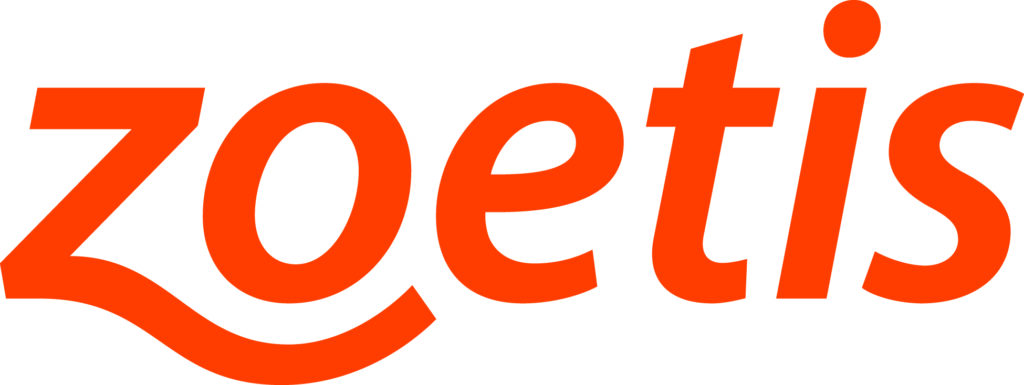
About Zoetis— Official USPC Equine Health and Wellness Partner
To learn more about how Zoetis is making lives better for horses and those who care for them, visit zoetisequine.com and Zoetis Equine on Facebook and Instagram.



